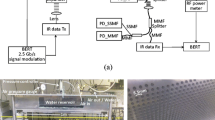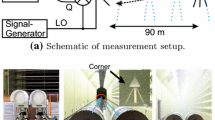Abstract
The effects of rain attenuation on 0.1- to 1-THz frequencies are reported in this paper. The THz pulses propagate through a rain chamber over a 4-m distance and are measured by THz time-domain spectroscopy (THz-TDS). A rain chamber is designed to generate controllable and reproducible rain conditions with different intensities. Image analysis software is employed to characterize the distribution of generated raindrop sizes. Theoretical THz power attenuations due to rain are calculated using Mie scattering theory and are compared with our measurements. Results show that both experimental and theoretical results are in very good agreement with each other.





Similar content being viewed by others
Reference
I. F.Akyildiz, J. M. Josep and C. Han. “Terahertz band: Next frontier for wireless communications,” Physical Communication, 12, 16-32 (2014).
K. Su, Z. Liu, R. B. Barat, D. E. Gary, Z. H. Michalopoulou, and J. F. Federici. “Two-dimensional interferometric and synthetic aperture imaging with a hybrid terahertz/millimeter wave system,” Applied Optics, 49, E13-E19 (2010).
Z. H. Michalopoulou, S. Mukherjee, Y. L. Hor, K. Su, Z.Liu, R. B. Barat, D. E. Gary, and J. F. Federici. “RDX detection with THz spectroscopy,” J. Infrared Millim. Terahertz Waves, 31, 1171-1181 (2010).
Z. Liu, K. Su, D. E. Gary, J. F. Federici, R. B. Barat, and Z. H. Michalopoulou. “Video-rate terahertz interferometric and synthetic aperture imaging,” Applied Optics, 48, 3788-3795 (2009).
J. F. Federici, B. Schulkin, F. Huang, D. Gary, R. Barat, F. Oliveira, D. Zimdars. “THz imaging and sensing for security applications - Explosives, weapons and drugs,” Semiconductor Science and Technology, 20, S266-S280 (2005).
T. Kürner. “Towards future THz communications systems,” Terahertz Science and Technology, 5, 11-17 (2012).
T. Kürner, S. Priebe. “Towards THz communications-status in research, standardization and regulation,” J. Infrared Millim. Terahertz Waves, 35, 53-62 (2014).
T. Kleine-Ostmann, T. Nagatsuma. “A Review on Terahertz Communications Research,” J. Infrared Millim. Terahertz Waves, 32, 143-171 (2011).
K. R. Jha, G. Singh. “Terahertz planar antennas for future wireless communication: A technical review,” Infrared Physics and Technology, 60, 71-80 (2013).
J. F. Federici, L. Moeller, K. Su. Terahertz Communication, in Handbook of terahertz technology for imaging and sensing. Woodhead Publishing, Cambridge, 2013.
J. F. Federici, L. Moeller. “Review of terahertz and subterahertz wireless communications,” Journal of Applied Physics, 107, 111101 (2010) .
J. Ma, F. Vorrius, L. Lamb, L. Moeller, J. F. Federici. “Experimental Comparison of Terahertz and Infrared Signaling in Laboratory-Controlled Rain,” J. Infrared Millim. Terahertz Waves, 1-10 (2015).
S. Cherry. “Edholm’s law of bandwidth,” IEEE Spectrum, 41, 58-60 (2004).
Y. Yang, M. Mandehgar, D. Grischkowsky. “THz-TDS Characterization of the Digital Communication Channels of the Atmosphere and the Enabled Applications,” J. Infrared Millim. Terahertz Waves, 36, 97-129 (2015).
K. Su, L. Moeller, R. B. Barat, J. F. Federici. “Experimental comparison of performance degradation from terahertz and infrared wireless links in fog,” J. Opt. Soc. Am. A, 29,179-184 (2012).
Y. Yang, M. Mandehgar, D. R. Grischkowsky. “Broadband THz signals propagate through dense fog,” IEEE Photonics Technology Letters, 27, 383-386 (2015).
K. Su, L. Moeller, R. B. Barat, J. F. Federici. “Experimental comparison of terahertz and infrared data signal attenuation in dust clouds,” J. Opt. Soc. Am. A, 29, 2360-2366 (2012) .
J. Ma, L. Moeller, J. F. Federici. “Experimental comparison of Terahertz and Infrared Signaling in a Controlled Atmospheric Turbulence,” J. Infrared Millim. Terahertz Waves, 35, 1-14 (2014).
R. L. Freeman. Radio System Design for Telecommunications. Wiley-IEEE Press, New York (2007) .
T. Utsunomiya, M. Sekine. “Rain attenuation at 103 GHz in millimeter wave ranges,” J. Infrared Millim. Terahertz Waves, 26, 1651-1660 (2005).
S. Ishii, S. Sayama, T. Kamei. “Measurement of Rain Attenuation in Terahertz Wave Range,” Wireless Engineering and Technology, 2, 119-124 (2011).
M. Sekine, S. Ishii, S. I. Hwang, S. Sayama. “Weibull raindrop-size distribution and its application to rain attenuation from 30 GHz to 1000 GHz,” J. Infrared Millim. Terahertz Waves, 28, 383-392 (2007).
T. Utsunomiya, M. Sekine. “Rain attenuation at millimeter and submillimeter wavelengths,” J. Infrared Millim. Terahertz Waves, 26, 905-920 (2005).
A. Hirata, R. Yamaguchi, H.Takahashi, T. Kosugi, K. Murata, N. Kukutsu, Y. Kado. “Effect of rain attenuation for a 10-Gb/s 120-GHz-band millimeter-wave wireless link,” IEEE Transactions on Microwave Theory and Techniques, 57, 3099-3105 (2009).
F. T. Ulaby, D. G. Long. Microwave Radar and Radiometric Remote Sensing. University of Michigan Press, Ann Arbor (2014).
ITU-R: Specific attenuation model for rain for use in prediction methods. Rec. P.838, ITU-R, (1999).
WMO: Guide to Meteorological Instruments and Methods of Observation. Geneva, Swizerland (2008).
Y. Yang, M. Mandehgar, D. Grischkowsky. “Time domain measurement of the THz refractivity of water vapor,” Optics Express, 20, 26208-26218 (2012).
Y. Yang, M. Mandehgar, D. Grischkowsky. “Determination of the water vapor continuum absorption by THz-TDS and Molecular Response Theory,” Optics Express, 22, 4388-4403 (2014).
C. F. Bohren, D. R. Huffman. Absorption and Scattering of Light by Small Particles. Wiley, New York (1983).
G. Ivanovs, D. Serdega. “Rain intensity influence on to microwave line payback terms,” Electronics and Electrical Engineering, 70, 60-64 (2006).
M. Khatib. Contemporary Issues in Wireless Communications. InTech, Croatia (2014).
Acknowledgments
This material is based upon work supported by the National Science Foundation under Grant No. ECCS-1102222. Technical assistance by C. Nicoletti with the THz-TDS instrument is gratefully acknowledged.
Author information
Authors and Affiliations
Corresponding author
About this article
Cite this article
Ma, J., Vorrius, F., Lamb, L. et al. Comparison of Experimental and Theoretical Determined Terahertz Attenuation in Controlled Rain. J Infrared Milli Terahz Waves 36, 1195–1202 (2015). https://doi.org/10.1007/s10762-015-0200-6
Received:
Accepted:
Published:
Issue Date:
DOI: https://doi.org/10.1007/s10762-015-0200-6




